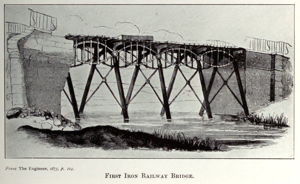 The remains of the world’s first cast iron railway bridge are to once again carry traffic as part of a footpath and cyclepath that is being built along the 26 miles of the Stockton & Darlington Railway, reports The Northern Echo.
The remains of the world’s first cast iron railway bridge are to once again carry traffic as part of a footpath and cyclepath that is being built along the 26 miles of the Stockton & Darlington Railway, reports The Northern Echo.
image: By Uncredited copy of a drawing first published in the Engineer in 1875….
… As the world’s first iron railway bridge, the bridge is a key part of our rail heritage…
The Northern Echo writes:
Historic England has… announced that it has awarded Durham County Council £161,000 to repair the remains of the bridge which carried the pioneering railway over the River Gaunless at West Auckland…
Giles Proctor, from Historic England, said: “Gaunless Bridge has a significant role in the history of the railway and the repair of its abutments mark the first step in securing the bridge’s legacy as a part of the new walking and cycling route.”
Cllr Elizabeth Scott, of the county council, said: “As the world’s first iron railway bridge, the bridge is a key part of our rail heritage, both at a local and national level….”
The bridge was cast by John and Isaac Burrell at their foundry in Forth Street, Newcastle, to the designs of either George… or Robert Stephenson. Its strength is in the “lenticular” shape of its leg supports – they look like a lentil seed or a biconvex lens and they enabled the bridge to be built without a single rivet or nut….
….The bridge remained in use until 1901 when it was no longer able to take the weight of the increasingly heavy coal wagons….
Niall Hammond, chairman of the Friends of the S&DR, said: “We are delighted with this and look forward to significant improvements to the landscape setting and interpretation so that visitors, school groups and the local community can appreciate the world class engineering marvel….We also hope very soon to see the metal sections of the bridge rescued from obscurity and given a suitable pride of place in Shildon at Locomotion Museum.”
